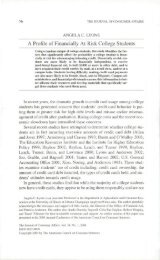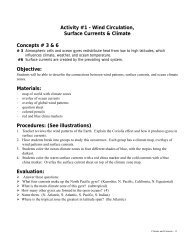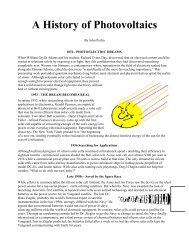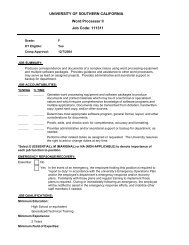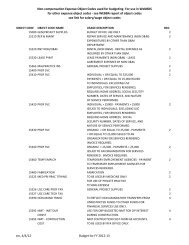Activity #5 - Predicting a Grunion Run - University of Southern ...
Activity #5 - Predicting a Grunion Run - University of Southern ...
Activity #5 - Predicting a Grunion Run - University of Southern ...
Create successful ePaper yourself
Turn your PDF publications into a flip-book with our unique Google optimized e-Paper software.
<strong>Activity</strong> <strong>#5</strong> - <strong>Predicting</strong> a <strong>Grunion</strong> <strong>Run</strong>Objective:Students will learn about the grunion runs in southern California and their relationship to the monthly tidecycle.Materials:· handouts· current tidal calendarProcedures:1. Students read the background information about grunion (below).2. Students read a tidal calendar (next page) to choose the highest four tides after the full moon for themonth.3. Using this information they will determine when the grunion will run (lay their eggs in the beach sand).Background information:The reproductive behavior <strong>of</strong> small, silvery fish Leuresthes tenuis (called the grunion) takes advantage<strong>of</strong> tidal cycles. <strong>Grunion</strong> spawn (lay their eggs) on the beach by swimming ashore with the higher tides.They can be seen on any sandy beach in southern California on certain nights during the months <strong>of</strong> Marchthrough August. The grunion come ashore a few days after a new or full moon during the evening tide. Youcan find them 1 to 3 hours after the peak <strong>of</strong> the highest high tide, from two to five days after the highest“spring tides” associated with the full or new moon. Hundreds, and sometimes thousands, <strong>of</strong> grunion can beseen on the beach at this time, furiously spawning. The females wiggle tail first into the sand and deposittheir orange eggs 3-8 cm deep in the sand. The males wrap their bodies around the females and release theirwhite milt, containing sperm. After spawning, the grunion return to the sea, leaving their fertilized eggs inthe sand where they will develop undisturbed by wave action for about ten days. At this time, the next high(spring) tide reaches the eggs, uncovering and agitating them. This initiates hatching and allows the larvalgrunion to swim to the sea and begin their lives as fish.Discussion:A- What days are the tides the highest after the full moon? After the new moon?B- What date on your tidal calendar has the largest tide range? What is the range in feet?C- Why do grunion lay their eggs as the tide recedes instead <strong>of</strong> as it is rising? To what danger might thisexpose the grunion?D- What will cause the eggs to be washed out <strong>of</strong> the sand? On what date will this occur?Leuresthes tenuisCalifornia <strong>Grunion</strong>max. length = 7.25 in<strong>Grunion</strong> - 1
<strong>Grunion</strong> - 2



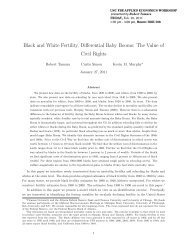
![15. RS 1.003 (RaJsu-yeni - nql?) RS 18.056 (RaJsu-yeni -5'[ ... ])](https://img.yumpu.com/51622603/1/189x260/15-rs-1003-rajsu-yeni-nql-rs-18056-rajsu-yeni-5-.jpg?quality=85)
